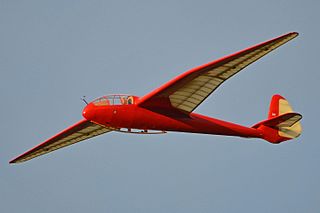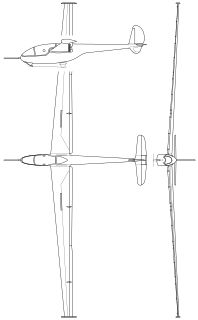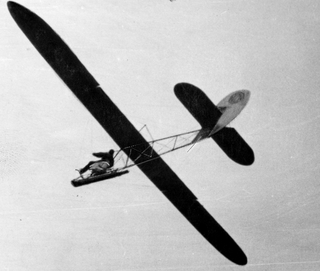
The Fauvel AV.36 was a single-seat tailless glider designed in France in the 1950s by Charles Fauvel. Although the "AV" in AV.36 stands for Aile Volante, it was not a true flying wing: it featured two large fins mounted on stubby tailbooms extending back from the wing's trailing edge, and accommodated the pilot within a stubby fuselage. The aircraft was designed to be quickly disassembled for road transport, with the nose detaching, and the fins able to fold back against the trailing edge of the wing. A refined version with a slightly longer wingspan, the AV.361 was introduced in 1960.

The SZD-6x Nietoperz was a single-seat tail-less experimental glider aircraft that was designed and built in Poland at Szybowcowy Zakład Doświadczalny in Bielsko-Biała in 1951. Only one example was constructed.
The IS-5 Kaczka was a single-seat canard research glider designed and built in Poland from 1948.
The Slingsby Type 26 Kite 2 was a post World War II development of the Slingsby Kite, a single seat medium performance sailplane. It sold in small numbers.

The Slingsby T.13 Petrel was a British single-seat competition glider built by Slingsby Sailplanes just before World War II.

The ESG Grunau 9, later known as the ESG 29 and post-1933 as the DFS 108-10, was one of the first primary gliders, built in Germany from the late 1920s. It was widely sold.
The Addyman Zephyr was a one-off, single-seat sailplane designed and built by Erik Addyman in the UK for his own use in the 1930s.
The Czerwiński Sparrow, sometimes known as the de Havilland Canada glider, was a single seat glider, designed and built by a group of de Haviiland engineers in Canada in 1942. It was intended to popularise gliding and be suitable for both basic training and thermal soaring.
The Manuel VI Primary was a wire-braced monoplane primary glider designed and built by W L. (Bill) Manuel whilst serving in the RAF in 1930. It flew successfully but only one was built.
The Reynard R.4 Primary was an open seat primary glider with an open girder fuselage and a high, wire braced wing. It was designed and built in the UK in 1930 and a few served Gliding Clubs in England and Ireland.

The Ikarus Meteor is a long-span, all-metal sailplane designed and built in Yugoslavia in the 1950s. It competed in World Gliding Championships (WGC) between 1956 and 1968 and was placed fourth in 1956; it also set new triangular-course world speed records.
The Horikawa H-22B-3 is a simple, open frame, two seat primary trainer glider designed and built in Japan in the 1950s.

The Caudron C.800, at first also known as the Epervier is a French two seat training glider, designed and first flown during World War II and put into large scale post-war production. It was the dominant basic training glider with French clubs until the 1960s and several still fly.

The Győr-2 was a high performance sailplane designed and built at the Aircraft Designer and Builder Group, Aeroclub of the Rolling-stock Factory, Győr in Hungary in the early 1950s.
The UTG-1 Loudon was an intermediate glider designed and built at the University of Toronto in Canada during the late 1940s.
The CVT1 Zigilo was a single-seat, 12 m (39 ft) span Italian training glider designed and built in Italy in the 1950s. Only one was completed.
TheNaleszkiewicz & Nowotny NN 1 was an experimental high performance sailplane flown in Poland in 1931. Despite having advanced features, a disappointing performance led to its early abandonment.

The Naleszkiewicz-Nowotny NN 2 was a Polish primary glider first flown in 1931. An improved version followed in 1932 but only three were built in total.
The Bréguet Br 902 Cinzano was a French training glider produced in the 1950s by Société anonyme des Ateliers d'aviation Louis Bréguet



















